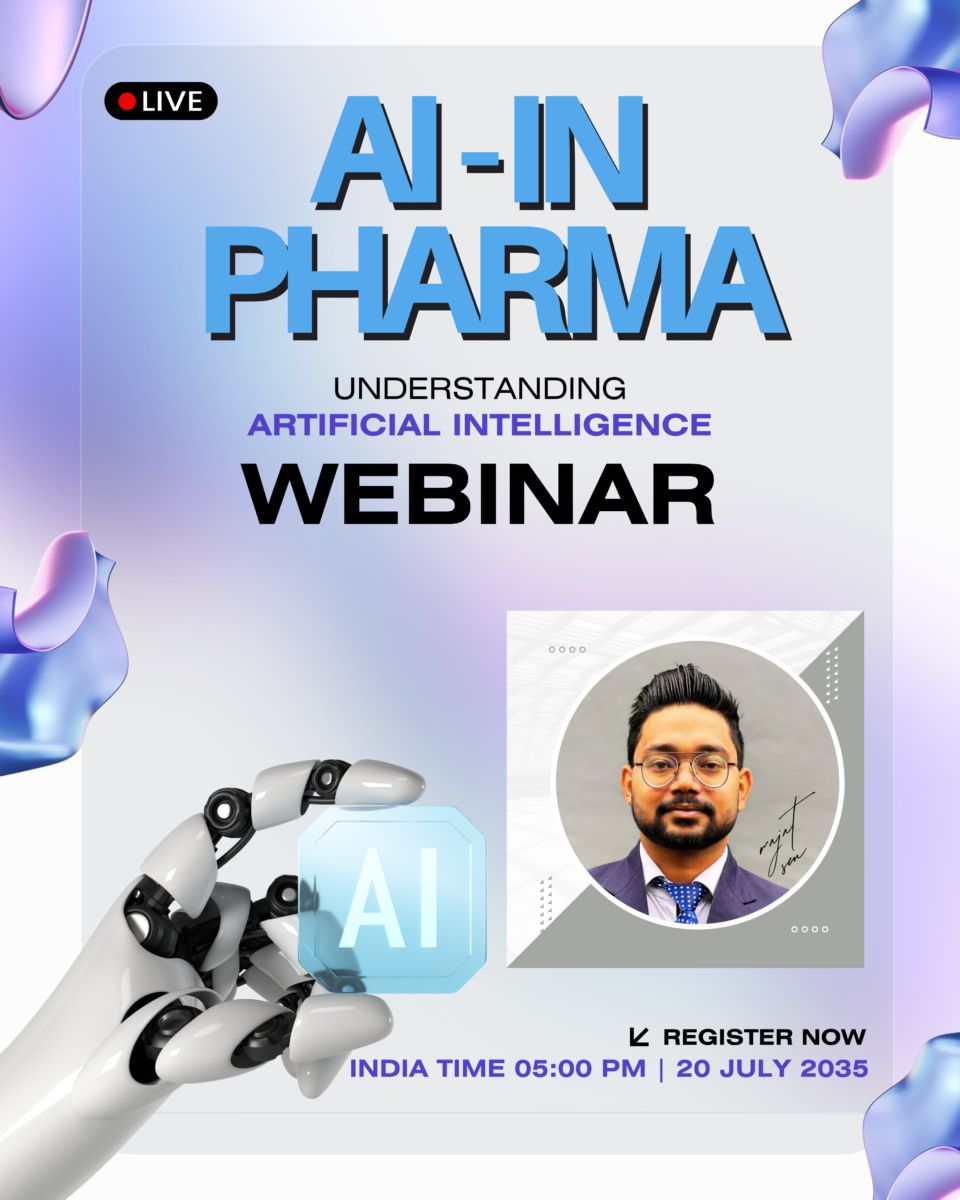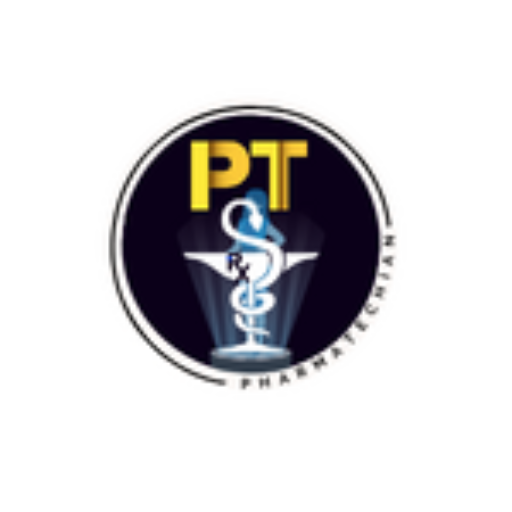Webinar Registration
- Home
- Webinar Registration
AI & No-Code: Navigating the Future of Pharma
A Professional Webinar for Students and Professionals
Slide 1: The AI Tsunami in Pharma
Title: The AI Tsunami: A New Era for the Pharmaceutical Industry
Key Points:
The global AI in drug discovery market is projected to skyrocket from $1.8 billion in 2024 to $14 billion by 2033, a CAGR of over 23%.
India’s AI in drug discovery market is expected to grow at an even more staggering CAGR of 83.57% from 2025 to 2032.
AI is not a buzzword; it’s a fundamental shift, moving from academic research into live, commercial applications.
In India, over 50% of pharma firms are already exploring Generative AI concepts.
Speaker Notes:
Start by acknowledging the audience’s background and the traditional nature of the industry.
Introduce the immense scale of AI’s financial impact with these powerful figures.
Emphasize that this is not a distant future—it’s happening now in India.
Slide 2: AI Use Cases for the Student & Researcher
Title: AI for Aspiring Pharma Leaders: From Lab to Lecture
Key Points:
Drug Discovery & Research: Students can use AI-powered platforms to analyze vast datasets, identifying new drug targets in a fraction of the time. For example, AI has helped reduce the time from target identification to Phase 2 clinical trials from years to just 18 months in some cases.
Literature Review: AI tools can sift through millions of research papers, patents, and clinical reports, helping students find relevant information in minutes, not days.
Personalized Learning: AI-driven platforms can tailor study materials and assessments to a student’s individual learning style, optimizing retention.
Examples in Action:
Drug Discovery: Insilico Medicine’s generative AI platform developed a novel drug candidate that went from target discovery to Phase IIa clinical trials in a significantly shortened timeframe.
Literature Review: Platforms like IBM Watson for Drug Discovery use AI to analyze unstructured text data, generating hypotheses that would be impossible for a human to find manually.
Personalized Learning: Ed-tech platforms like PharmaVirtualAcademy can use AI to create adaptive quizzes that adjust difficulty based on a student’s performance, ensuring they master concepts.
Speaker Notes:
Connect these points to the student’s daily life—research papers, studying for exams, and getting a head start on their careers.
Mention specific examples like using AI to find patterns in genomics data.
Slide 3: AI Use Cases for the Professional & Job Seeker
Title: Career Acceleration with AI: Your Competitive Edge
Key Points:
Optimizing Clinical Trials: AI helps identify the right trial participants more efficiently, which is a major pain point, as patient recruitment accounts for ~37% of trial postponements.
Supply Chain Optimization: AI predicts demand and streamlines logistics, reducing waste and ensuring product availability.
Enhancing Career Tools: AI can be used to create ATS-friendly resumes and cover letters, and to simulate interview scenarios, providing instant feedback.
Examples in Action:
Clinical Trials: Companies like IQVIA use AI to analyze medical records and genetic data to rapidly identify ideal candidates for trials, accelerating patient recruitment.
Supply Chain: GSK Pharma uses AI and machine learning to predict demand fluctuations and optimize inventory levels, reducing stockouts and overstocking.
Career Tools: Your own platforms, like PharmaTechian.com, can integrate AI to help job seekers generate personalized, ATS-friendly resumes by analyzing job descriptions and their own skill sets.
Speaker Notes:
Focus on how AI solves real-world problems professionals face.
Use the statistic about clinical trial delays to highlight AI’s tangible value.
Directly address the job seeker, linking AI to personal career growth.
Slide 4: AI Use Cases for the Business
Title: Transforming Pharma Business: From R&D to Revenue
Key Points:
Accelerated R&D: AI cuts development timelines by predicting molecular efficacy and side effects, potentially saving millions in failed projects.
Regulatory & Compliance: AI automates the generation of complex regulatory documents, which can number in the hundreds of thousands of pages, ensuring accuracy and saving time.
Marketing & Sales: AI analyzes market data to identify unmet patient needs and optimize sales strategies, leading to better ROI.
Examples in Action:
Manufacturing: Cipla India leveraged AI-powered scheduling solutions to reduce manufacturing changeover durations by 22%, significantly improving operational efficiency.
Predictive Maintenance: Johnson & Johnson India uses AI to predict when machinery needs maintenance, preventing costly unplanned downtime in manufacturing plants.
Regulatory Automation: Companies like Pfizer are training AI systems to assist in creating highly accurate labeling content for new drugs, a process that can be incredibly time-consuming.
Speaker Notes:
Frame these points in terms of efficiency, cost reduction, and market leadership.
Highlight the fact that AI-powered solutions can reduce development time by up to 90% and help avoid costly regulatory delays.
Slide 5: The No-Code/Low-Code Revolution
Title: Building the Future, No Code Required
Key Points:
What is No-Code? It’s a visual approach to software development, allowing anyone to build applications without writing a single line of code.
The global no-code/low-code market is growing rapidly, with 70% of new applications expected to use these technologies by 2025.
No-code tools enable “citizen developers”—pharma professionals, students, and academics—to solve their own digital challenges.
Speaker Notes:
Define no-code in simple terms and use the impressive market statistics to underscore its importance.
Use an analogy: “Think of it like designing a presentation slide. You’re building something complex, but you don’t need to know the underlying programming language.”
Slide 6: No-Code for the Student & Teacher
Title: Innovate on Campus: No-Code in Academia
Key Points:
For Students: Build custom tools for research, like a simple database to track literature, a quiz app for pharmacology, or a case study generator.
For Teachers: Create interactive learning modules, automated student feedback systems, or a simple portal for sharing lab protocols and data.
Examples in Action:
Simulated Learning: A pharmacy student can use a no-code platform to build a virtual simulation of a community pharmacy to practice prescription dispensing and patient counseling.
Data Management: A researcher can create a simple no-code app to manage and visualize their clinical data, allowing them to track patient progress and identify trends without IT support.
Speaker Notes:
Provide concrete, actionable examples that the audience can immediately understand and try.
Emphasize that this is about practical problem-solving and skill-building.
Slide 7: No-Code for the Job Seeker & Employer
Title: Bridging the Skill Gap: No-Code for Professionals
Key Points:
For Job Seekers: Build a professional portfolio that goes beyond a resume. Create a no-code app to showcase your domain expertise—for instance, a dashboard visualizing pharmaceutical sales data or a simple clinical trial enrollment tracker.
For Employers: Empower your teams to build internal tools without burdening the IT department. This can include simple inventory management systems, a sales team performance dashboard, or a streamlined patient communication portal.
Examples in Action:
Patient Portals: A hospital can use a no-code platform to quickly build a custom patient portal for appointment scheduling, viewing lab results, and secure communication, improving patient experience.
Manufacturing Inventory: A pharma company can create a no-code app for their warehouse staff to track raw materials and finished products in real-time, reducing errors and ensuring an audit trail.
Speaker Notes:
This slide is critical for your vision of bridging the industry-academia gap.
Stress that no-code isn’t a replacement for developers, but a way to empower domain experts to innovate.
Slide 8: The PharmaTechian Ecosystem & Your Next Step
Title: The Future is You: Taking Action
Key Points:
The Power of Combination: The real magic happens when you combine your pharma knowledge with AI and no-code tools.
Your Journey Starts Now: Don’t wait for others to lead; become a pioneer in this transformation.
PharmaTechian.com: Your platform for mentorship, skill-building, and real-world tools. We are building the ecosystem to support your journey.
Speaker Notes:
This is the call to action. Reiterate the webinar’s main message.
Tie everything back to your company’s mission and how you provide the tools and support.
Slide 9: Q&A
Title: Questions & Discussion
Key Points:
Open the floor for questions from the audience.
Thank the audience for their time and engagement.
Speaker Notes:
Be ready to answer questions and engage with the audience on a deeper level.
Acknowledge their curiosity and encourage further dialogue.



